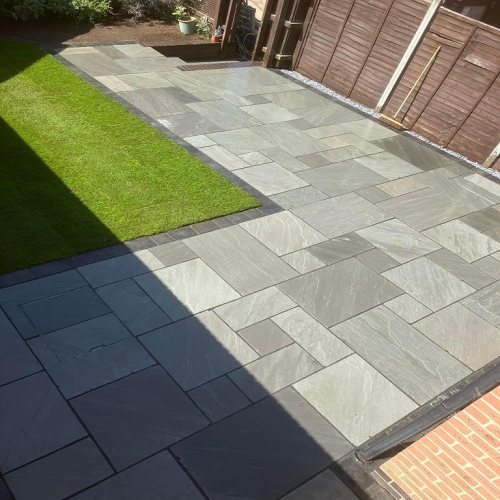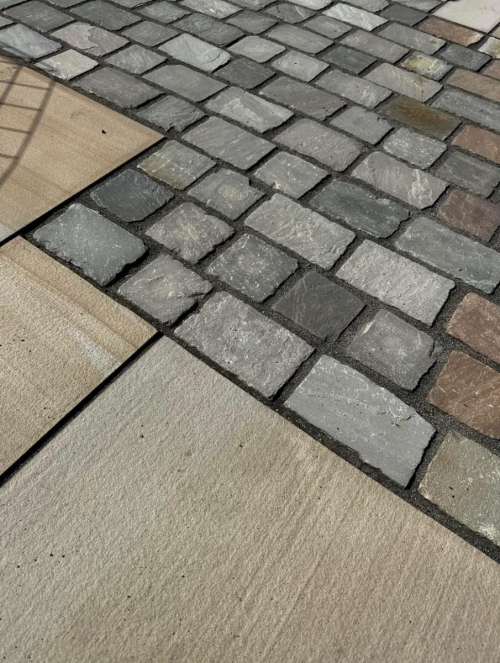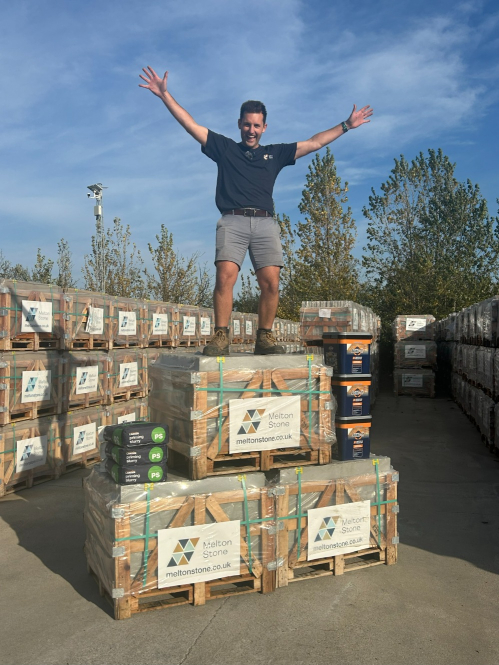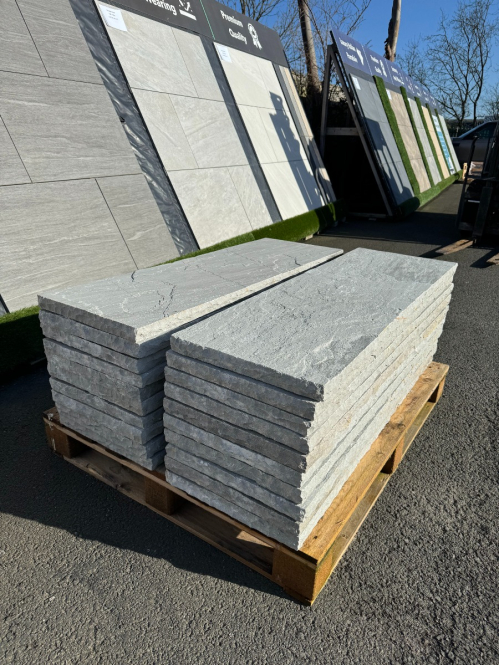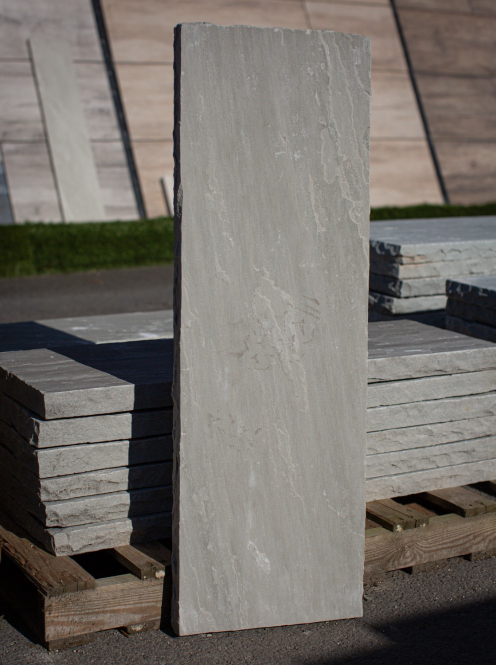Kandla Grey Sandstone
Kandla Grey Indian Sandstone paving has been one of the UK’s favourite natural stone paving choices for many years due to it been very hard wearing and the grey sandstone appearance looks great with all types of house brick colours.
Kandla grey paving slabs are available in a wide range of finishes such as riven, sawn smooth honed, wall copings and cobbles.
Whatever your budget we have a beautiful range of Kandla Grey sandstone paving to suit your garden project.
- Dense, heavy duty, durable natural stone paving.
- Excellent slip rating
- Extremely Hard Wearing
- Low Maintenance
If you would to find out more about our beautiful paving selection please contact one of our paving experts today.
Speak to a member of our friendly sales team today on 01482 688008 or Email sales@meltonstone.co.uk
Kandla Grey Sandstone Paving
Is Kandla Grey sandstone good for patio?
Yes, Kandla Grey sandstone is an excellent choice for a patio. Kandla Grey is a type of Indian sandstone known for its beautiful blend of grey tones, making it a popular option for outdoor paving projects, including patios. There are several reasons why Kandla Grey sandstone is well-suited for patios:
1. Aesthetic Appeal: Kandla Grey sandstone has a natural and rustic appearance with its various shades of grey, creating a timeless and elegant look for your patio.
2. Versatility: The neutral colour of Kandla Grey complements a wide range of design styles, from traditional to contemporary, allowing you to create the desired atmosphere in your outdoor space.
3. Durability: Indian sandstone, including Kandla Grey, is a durable material that can withstand outdoor elements, making it suitable for long-lasting patio installations.
4. Texture: The natural texture of Kandla Grey sandstone provides a non-slip surface, which is essential for outdoor areas like patios, especially in wet conditions.
5. Coolness: Sandstone has the property of remaining relatively cool in hot weather, making your patio comfortable to walk on, even during sunny days.
6. Low Maintenance: Kandla Grey sandstone is relatively easy to maintain. Regular cleaning and occasional resealing (if desired) can keep your patio looking its best.
7. Cost-Effective: Indian sandstone, including Kandla Grey, is often more affordable than some other natural stone options, making it a cost-effective choice for a patio.
When using Kandla Grey sandstone for your patio, consider the layout and the choice of laying pattern, as well as any additional design elements like edging and landscaping that will enhance the overall look of your outdoor space.
What pattern to lay Kandla Grey Indian Sandstone?
Kandla Grey Indian sandstone can be laid in various patterns to create different visual effects and suit the overall design of your outdoor space. The choice of laying pattern depends on your preferences, the size and shape of the pavers, and the dimensions of the area you are paving. Here are some popular laying patterns for Kandla Grey Indian sandstone:
1. Random/Random Ashlar: This pattern involves using pavers of different sizes and laying them in a random arrangement. The result is a natural and informal look that works well for rustic or cottage-style gardens.
2. 90-Degree Herringbone: In this pattern, rectangular pavers are laid at a 90-degree angle to create a "V" or herringbone effect. This pattern provides a classic and traditional look that can visually enhance the size of the space.
3. Basket Weave: The basket weave pattern involves laying pairs of rectangular pavers horizontally and vertically, creating a woven appearance. This pattern is visually interesting and works well for small to medium-sized areas.
4. Running Bond: In a running bond pattern, pavers are laid in staggered rows, with each paver half-offset from the one above and below it. This pattern is easy to install and creates a clean and contemporary look.
5. Circular/Radial: Circular or radial patterns involve arranging the pavers in circles, curves, or radiating lines. These patterns can be eye-catching focal points in the garden and are well-suited for features like patios or seating areas.
6. Checkerboard: This pattern involves alternating two different colours of pavers to create a checkerboard effect. It can add a playful and dynamic element to the space.
Before choosing a pattern, consider the size and shape of the pavers, as some patterns work better with certain paver sizes. Also, think about the practicality of the pattern and how it will fit within the overall design of your outdoor space.
Do I need to seal Kandla Grey pavers?
Sealing Kandla Grey pavers is not always necessary, but it can be beneficial depending on your preferences and the specific conditions of your installation. Kandla Grey is a type of Indian sandstone known for its attractive blend of grey tones, making it a popular choice for outdoor paving projects.
Should I put slurry on Indian Sandstone paving?
Using a priming slurry or slurry primer on Indian sandstone paving is a personal choice, and it depends on the specific requirements of your paving project and the type of sandstone you are using. A slurry primer is a thin, watery mix of cement and water that is brushed or sprayed onto the back of the paving stones before they are laid on the bedding mortar.
What is best grout for Indian Stone?
The best grout for Indian stone, including sandstone like Raj Green, depends on the specific project and the joint width between the stones. Two common types of grout used for natural stone like Indian sandstone are cement-based grout and resin-based grout.
1. Cement-Based Grout: Cementitious grouts are a traditional and widely used option for natural stone. They are made of a mixture of cement, sand, and sometimes additives. Cement-based grouts are suitable for joints that are at least 3mm (approximately 1/8 inch) wide. They come in various colours, allowing you to choose a shade that complements the Indian stone.
2. Resin-Based Grout: Resin-based grouts are a more modern alternative that offers some advantages over cement-based grouts. They are typically suitable for joints ranging from 1mm to 6mm (approximately 1/16 to 1/4 inch) wide. Resin-based grouts are water-resistant, flexible, and less prone to cracking compared to cement-based grouts. They can be a good choice for projects with narrower joints or in areas where increased flexibility is desired.
When choosing grout for your Indian stone project, consider the following factors:
Joint Width: Ensure the grout you select is compatible with the joint width between the Indian stone pavers. Choosing the appropriate grout width will ensure proper bonding and aesthetics.
Traffic Load: Consider the level of foot or vehicular traffic the paved area will experience. For driveways or high-traffic areas, a more durable and resilient grout might be preferable.
Colour: Choose a grout colour that complements the Indian stone and enhances the overall appearance of the paved surface.
Sealing: Depending on the grout type and the porosity of the Indian stone, you may need to apply a suitable sealer to protect the grout from staining and the stone from potential moisture infiltration.

